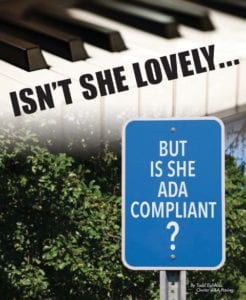When Steveland Morris was born premature, he was rushed into an incubator. An excess of oxygen caused him to lose his sight. But like his hero Ray Charles, Morris turned to music, learning how to play several instruments, including drums, piano and harmonica. Discovered by a member of Smokey Robinson’s group, The Miracles, the 11 year-old was brought to Motown Records. In short order, he became Stevie Wonder and had the first of many #1 hits.
Your community association homeowners and residents, or their visitors, may not be Rock & Roll legends, but everyone has the right to accessible parking spaces. Created in 1990 to ensure people with disabilities have fair and equal access to work and public spaces, ADA regulations were updated in 2010 and now encompass all minimum federal requirements for your parking lot to be deemed ADA compliant. The size, number of spaces, slope and marking of accessible spots vary depending on the overall size of the parking lot and number of spaces. Beyond federal regulations, your parking lot must also meet all current state regulations. Specific requirements often vary from state to state.
In the state of Illinois, A U.S. Department of Transportation R7-8 (Reserved Parking) and a R7-I101 ($250 fine) sign must be mounted on a permanent post no lower than five feet from the pavement. The post must be mounted in the center of the 16-foot wide accessible parking space, no more than five feet from the front of the parking space.

What are the most common mistakes in new parking lot planning and construction? Without a doubt, aisle access to the building entrance is the biggest source of error. The ADA compliant parking space aisle has to be connected to an access route that leads to the entrance of the building without going into the path of traffic. This is a notorious problem in almost every facility, even new construction. Take a look at the big box stores in your area and see whether there’s a clearly defined access route leading from their accessible parking spaces to the front door. Usually, there is not.
Slope issues can plague the rest of the parking space too. Even if the parking spaces are the right dimension and correctly striped, many exceed the maximum slope of 1:48. How does this happen? Either the initial grading wasn’t done well or, frankly, it’s very hard to level asphalt paving.
Often you find that catch basins and drains are installed near the stalls – exactly where you don’t want them – and there tends to be a steep slope toward the drain. Working with a knowledgeable paving company can make accessible parking lot requirements fairly straightforward and easy to install.
Not sure whether your existing parking lot is in compliance? Taking proactive steps now will help keep you ahead of that curve. If a comprehensive ADA evaluation of a parking lot has been completed in the past, that’s good. Now it’s time to take it off the shelf, and read it. Look for the inspection date. If it’s been since the 2010 federal ADA updates, you may want to check Illinois code as well, as it frequently changes. See www.illinois.gov for specific details. The State of Illinois ADA compliance regulations currently stipulate:
Any facility offering parking for tenants or visitors must provide accessible parking for people with disabilities. An accessible parking space consists of a vehicle space and a striped access aisle. The entire space must be kept clear of obstructions at all times, including ice, snow, shopping carts, trash cans, seasonal garden displays, and bicycle racks.
If a comprehensive ADA evaluation of the parking lot has not been recently performed, this may be the time todo it. Having an outside paving professional perform the evaluation provides a second set of eyes and professional experience in ADA compliance. Some property managers may wonder why that might be necessary. There are several reasons, but the biggest one is simple: It’s federal law. If any organization, including community associations, is not in compliance with the ADA, it may be only a matter of time before someone is slapped with a lawsuit.
Today, 27 years after the Americans with Disabilities Act (ADA) was signed into law, a significant number of property owners covered under this federal law continue to be sued for their failure to comply with the standards. Accessible parking spaces seem uncomplicated, but they frequently trip up property owners who don’t realize that there’s more to parking spaces than just painting the International Symbol of Access on the ground. Avoid the headache of lawsuits or penalties and make sure your parking lot is serving all of your homeowners – and their guests. Seeking proper guidance from Accredited, professional paving companies can provide peace of mind, and ensure your parking lots are accessible – and really lovely – for everyone. Then you’re really ready to Rock & Roll!




 Brittany Kojzarek
Brittany Kojzarek 
 Katy Casserly
Katy Casserly 


